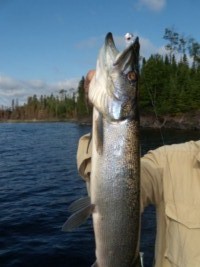Blue Northern Pike – A Rarity
Category: article
Aug 18th, 2010 by OutdoorsFIRST
Modified Aug 18th, 2010 at 12:00 AM
OK, if readers think the summer of 2010 is all blue for me, here’s the story. It is! Earlier, on a trip to Pasha Lake Camp north of Thunder Bay, Ontario, my fishing partner Pastor Mark Boone and I caught several blue pike (which are really blue walleyes), but the name follows them from Lake Erie in the early 1900’s. That adventure is documented and in the News archives of Walleye First under the title, “Is it a Walleye?”
 |
|
|
|
Now, on a recent foray into Northwest Ontario with college buddy and life-long friend, geologist Greg Thurow from Sheridan, Wyoming, we were fishing the lake adjacent to their gold exploration camp. On Springpole Lake, the walleyes were almost too numerous – but we survived the constant thumps and whacks on our jigs and plastic. We reached Springpole by plane from Red Lake.
The pike were also active. Greg hooked a fish, and when it went whizzing by the boat, we both looked in amazement and said in unison, “What’s that!?” Greg hoisted it into the boat and said, “Blue Pike.”
Indeed it was the bluest fish I had ever seen. It may have been even bluer than the walleyes we caught in May. When Greg described it, he was extremely accurate. I remembered catching one about 20 years ago on Thaddeus Lake, north of Dryden. This was only the second one I had seen.
 |
|
|
Blue Pike
|
The research about blue pike, or since the blue walleye already has that name, are known as “silver” pike. Research proves they are indeed rare. From an Ontario Fisherman magazine article, it’s reported that Canadian researchers over seven years sampled only 42 blue/silver pike compared to 19,378 normal pike in their nets. Other factoids from that article:
** “Silver pike have no body spotting…exhibits beautiful iridescent blue-silver flanks.”
** “…sheeny, blue sides, nearly clear fins and scales so fine they look and feel like those of a trout.”
** “Documented occurrences are from virtually every part of the known range of northern pike around the world.”
** “Eddy and Shurber in 1943 stated that the silver pike was a true breeding mutant of the normal pike.”
** “When crossed with normal pike in hatcheries, the resulting crosses had peculiar black-mottled markings… (like those) found on a black crappie.”
** “Perhaps, a regularly occurring genetic mutation is present in the normal pike population that periodically produces these unique looking fish.”
** Casselman, a researcher noted, “The tips of the blue pike’s tail are significantly more pointed than those found on northern pike.”
The Minnesota Department of Natural Resources in their fish ID literature tells us, “An uncommon variant called the silver pike is dark silver or greenish gray, rather like the “clear” coloration of the muskie; yet it is a northern pike and has the northern pike’s scale and pore pattern.” The Minnesota state record silver pike is 18 pounds, 14 ounces.
While I don’t know much more, I know that after chasing northern pike throughout North America, all across Canada and from Montana to New York for more than 50 years, I have only been in boats when two blue/silver pike have been landed. Conducting pike seminars throughout the same wide region, I have been asked hundreds of questions, but never anything about blue/silver pike. They must be as rare as the researchers have noted. But, of interest is that they are present wherever normal pike swim – just not many.
If you find a blue/silver pike on the end of your line, share it with readers on this website. The photos are of Greg Thurow and his specimen, which is back in the lake.